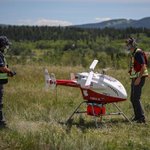
by Ric | Jan 12, 2020 | Land, News Brief |
Bipedal Package Delivery Drones? 0 Comments Written by Ric January 12, 2020 Image Source: Agility Robotics Ford recently announced they bought the first two units of Agility Robotics’ “Digit”, a commercially available bipedal package delivery robot that can pick and stack packages of up to 40 lbs (18 kg). The move is part of Ford’s current exploration into last-mile logistics, particularly in the case of supporting self-driving delivery vans. Digit’s bipedal design allows it to better navigate through complex, human environments such as stairs, a key obstacle for autonomous curb-to-doorstep delivery. It’s four degree-of-freedom (4-DOF) arms also allow it to it push open doors or even push itself up after falling down. According to the Verge, each Digit unit is priced in the low to mid six figures. However when factoring in maintenance and lifespan, this number roughly translates into an hourly cost of ~ $25. In addition to door-to-door logistics, the 100 pound (45 kg) Digit could potentially perform warehouse/stockroom work, or even infrastructure inspection as part of its delivery route. Image Source: Agility Robotics Related Articles Browse All Categories...

by Ric | Sep 28, 2016 | Air |
28 SEPTEMBER, 2016 Pizza Delivery Drones Mamma Mia! Will full-scale pizza drone delivery services be the next big thing? This past August, pizza powerhouse Domino’s made history by announcing it was trialling pizza deliveries via drone in New Zealand. Check out the video of the successful delivery here. Experimentation with drone deliveries is nothing new for Domino’s. In 2013 they did a promotional stunt in the UK (video link: YouTube) and just this past June they did something similar in Greece (video link: YouTube) while also showcasing a prototype of their future “zero click ordering” app with a 10-second countdown. This time around however, Domino’s has partnered up with Flirtey, the company who this past year alone has trialled drone delivery of medical supplies as well as drone delivery of 7-Eleven goodies such as coffee, donuts, a chicken sandwich and a Slurpee. This partnership is part of Domino’s long-term strategy to automate delivery alongside the company’s future fleet of 190 kg (419 lb) Domino’s Robotic Units (aka DRUs) which are the company’s (potentially solar powered) commercial autonomous delivery vehicles ready to deliver up to 10 hot pizza pies within a 20 km (12.4 mile) radius of their home franchise base. Is Domino’s the first to come up with this concept of flying pizzas? No. But they are most likely the first to be able to make it happen at a commercial level. University students and their supervisor in Berlin work on devouring the first pizza successfully delivered via drone back in 2012. Screen capture via YouTube Pizza Drones Then Leonardo The Pizza Delivery Copter (Germany, 2012) A Free University of Berlin student project, this...

by Ric | Nov 16, 2015 | Air |
Walmart is the latest retail giant to consider package delivery via drone Unmanned Cargo Delivery Concept – Chronicle 21 Walmart seeks to test drones for home delivery, pickup (October 26, 2015) (Editor’s Note: Amazon assures US$1 drone deliveries in 30 minutes. Google promises to cover 5 miles in 5 minutes. What can Walmart offer that is different?) What the Article Chronicles: The physical retail giant Walmart has applied with the Federal Aviation Administration (FAA) to test drones for several purposes such as home delivery, grocery pickup and warehouse inventory management. The goal? To complement their “vast network of stores, distribution & fulfillment centers and transportation fleet” with a drone flotilla to better expand their commercial reach. After all, “there is a Walmart within five miles of 70 percent of the U.S. population, which creates some unique and interesting possibilities for serving customers with drones”. Taking into consideration current drone technology limitations, it is most likely Walmart will begin by using their drones for inventory management outdoors. These drones (likely based on the DJI Phantom 3 Professional series) would fly around Walmart’s distribution center parking lots and take stock of trailers via electronic tagging (to detect inventory still packed inside their containers). Alternatively, the drones could make visual scans of the inventory inside a typical Walmart million square foot (92,900 square meter) distribution center. The technology employed in this case would likely be similar to the tech employed by South African inventory management startup – DroneScan – which uses UAVs to scan barcodes that would normally be too difficult to reach for humans in a typical warehouse environment. However, Walmart does seem...

by Ric | Sep 17, 2015 | Air |
UAV Equipped Delivery Trucks: Why Dogs Will No Longer Be Able to Bite the Mailman Unmanned Cargo Delivery Concept – Chronicle 15 Source: Amazon and Google aren’t the only ones with a delivery drone (July 28, 2015) (Editor’s Note: Full cartoon can be found at anewdomain.net. Also, a new delivery drone humor section is coming soon, stay tuned!) [UPDATE: New concept video can be found at https://www.youtube.com/watch?v=epqZ-IuhzKQ] What the Article Chronicles: Yard dogs hankering for a taste of the local mailman’s / delivery man’s tender calves are plain out of luck. AMP Holding Inc. (in cooperation with the University of Cincinnati) has developed an unmanned, wirelessly recharging octocopter that can attach itself to the top of a delivery truck and autonomously deliver packages thereby foiling those hungry pooches’ plans. Called the HorseFly (as pun to the fact that its “base” is AMP’s WorkHorse electric delivery vehicle), the overall concept combines autonomous and manual control. Once a specific address is determined as best suited for drone delivery, the driver hands over the package via a rooftop access hatch. The HorseFly then scans the barcode on the package, determines the best flight path based on its current GPS coordinates and then flies itself off to the delivery location. However, once it gets close to the drop off point, a certified drone operator will remotely take over control and guide the drone around unpredictable urban obstacles in order to safely release the package. Once delivery is complete, the HorseFly resumes autonomous flight back to its delivery truck where it can wirelessly recharge. By using the WorkHorse electric delivery truck as both landing pad and...

by Ric | Sep 10, 2015 | Air |
Package Delivery Unmanned Aerial Vehicle (UAV) Highway Concept Proposed by Amazon Unmanned Cargo Delivery Concept – Chronicle 13 Amazon Proposes Drone Highway as It Readies for Flying Package Delivery (July 28, 2015) (Editor’s Note: This article kicks off a 3 post series look at the latest concepts for managing the increasing number of drones vying for precious limited airspace in the future.) What Article Chronicles: Amazon has recently published a pair of whitepapers (Paper 1 / Paper 2) describing their proposed approach for determining safe and efficient airspace access and integration for low-altitude, small unmanned aerial vehicles (UAVs). To fully reap the benefits of commercial drone systems in civil airspace, and in order to avoid potentially lethal chaos as per the recent example of a Southern California 3,500 acre wildfire where helicopter firefighting operations were temporarily stopped for 26 minutes due to the interfering presence of five civilian-operated drones, dedicated “air lanes” and air traffic control systems will be key to avoiding a bleak dystopian “delivery drones blocking out the sun” future outlook. Amazon’s concept focuses on a “segregated airspace” below 500 feet (152 meters). Airspace above this height is where most civil and military aviation activities takes place. Amazon suggests the following four segregated areas: Below 200 feet (61 meters) a “Low-Speed, Localized Traffic” area reserved for “(1) terminal non-transit operations such as surveying, videography and inspection, and (2) operations for lesser-equipped vehicles, e.g. ones without sophisticated sense-and-avoid (SAA) technology”. Potentially, this area would also be the airspace where Amazon Prime Air drones would complete the final stages of their parcel deliveries, landing near homes to drop off Amazon packages. Between...









